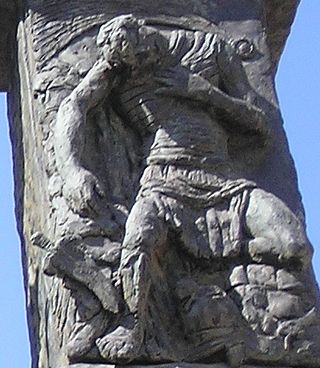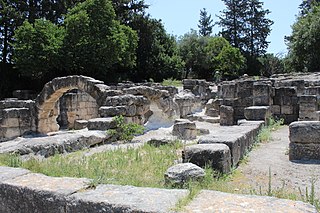
The Mishnah or the Mishna is the first written collection of the Jewish oral traditions that are known as the Oral Torah. It is also the first work of rabbinic literature,with the oldest surviving material dating to the 6th to 7th centuries CE.

The Talmud is,after the Hebrew Bible,the central text of Rabbinic Judaism and the primary source of Jewish religious law (halakha) and Jewish theology. Until the advent of modernity,in nearly all Jewish communities,the Talmud was the centerpiece of Jewish cultural life and was foundational to "all Jewish thought and aspirations",serving also as "the guide for the daily life" of Jews. The Talmud includes the teachings and opinions of thousands of rabbis on a variety of subjects,including halakha,Jewish ethics,philosophy,customs,history,and folklore,and many other topics.
The Pharisees were a Jewish social movement and school of thought in the Levant during the time of Second Temple Judaism. Following the destruction of the Second Temple in 70 AD,Pharisaic beliefs became the foundational,liturgical,and ritualistic basis for Rabbinic Judaism. Although the group no longer exists,their traditions are of great importance for the manifold Jewish religious movements.

Jewish history is the history of the Jews,their nation,religion,and culture,as it developed and interacted with other peoples,religions,and cultures.

The Jewish diaspora,dispersion or exile is the dispersion of Israelites or Jews out of their ancient ancestral homeland and their subsequent settlement in other parts of the globe.

The Bar Kokhba revolt was a large-scale armed rebellion initiated by the Jews of Judea,led by Simon bar Kokhba,against the Roman Empire in 132 CE. Lasting until 135 or early 136,it was the third and final escalation of the Jewish–Roman wars. Like the First Jewish–Roman War and the Second Jewish–Roman War,the Bar Kokhba revolt resulted in a total Jewish defeat;Bar Kokhba was killed by Roman troops at Betar in 135,and the Jewish rebels who remained after his death were all killed or enslaved within the next year.

The Jewish–Roman wars were a series of large-scale revolts by the Jews of Judaea against the Roman Empire between 66 and 135 CE. The term primarily applies to the First Jewish–Roman War (66–73) and the Bar Kokhba revolt (132–136) which sought restoring Judean independence that was lost since the Hasmonean civil war. Some sources also include the Diaspora Revolt (115–117),a campaign waged by the Jewish diaspora across the Eastern Mediterranean.

Menahem Stern was an internationally acclaimed Israeli historian of the Second Temple period. He was murdered in Jerusalem by Palestinians during the First Intifada.
Hellenistic Judaism was a form of Judaism in classical antiquity that combined Jewish religious tradition with elements of Hellenistic culture and religion. Until the early Muslim conquests of the eastern Mediterranean,the main centers of Hellenistic Judaism were Alexandria in Egypt and Antioch in Syria,the two main Greek urban settlements of the Middle East and North Africa,both founded in the end of the 4th century BCE in the wake of the conquests of Alexander the Great. Hellenistic Judaism also existed in Jerusalem during the Second Temple Period,where there was a conflict between Hellenizers and traditionalists.

Sefer Zerubavel,also called the Book of Zerubbabel or the Apocalypse of Zerubbabel,is a medieval Hebrew-language apocalypse written at the beginning of the seventh century AD in the style of biblical visions placed into the mouth of Zerubbabel,the last descendant of the Davidic line to take a prominent part in Israel's history,who laid the foundation of the Second Temple in the sixth century BC. The enigmatic postexilic biblical leader receives a revelatory vision outlining personalities and events associated with the restoration of Israel,the End of Days,and the establishment of the Third Temple.

The Second Temple period or post-exilic period in Jewish history denotes the approximately 600 years during which the Second Temple stood in the city of Jerusalem. It began with the return to Zion and subsequent reconstruction of the Temple in Jerusalem,and ended with the First Jewish–Roman War and the Roman siege of Jerusalem.

Shmuel Safrai was Professor Emeritus of Jewish History at Hebrew University and laurate of the Israel Prize for Land of Israel studies for 2002.
ʽAm haʼaretz is a term found in the Hebrew Bible and in rabbinic literature.

The Jews or Jewish people are an ethnoreligious group and nation originating from the Israelites of the historical kingdoms of Israel and Judah,and whose traditional religion is Judaism. Jewish ethnicity,religion,and community are highly interrelated,as Judaism is an ethnic religion,but not all ethnic Jews practice Judaism. Despite this,religious Jews regard individuals who have formally converted to Judaism as Jews.

The history of the Jews in the Roman Empire traces the interaction of Jews and Romans during the period of the Roman Empire. A Jewish diaspora had migrated to Rome and to the territories of Roman Europe from the land of Israel,Anatolia,Babylon and Alexandria in response to economic hardship and incessant warfare over the land of Israel between the Ptolemaic and Seleucid empires from the 4th to the 1st centuries BC. In Rome,Jewish communities thrived economically. Jews became a significant part of the Roman Empire's population in the first century AD,with some estimates as high as 7 million people;however,this estimation has been questioned.
Yom tov sheni shel galuyot,also called in short yom tov sheni,means "the second festival day in the Diaspora". This is a principle in halakha that mandates the observance of an additional day for Jewish holidays outside the Land of Israel.
Sicaricon,lit. 'usurping occupant;possessor of confiscated property;the law concerning the purchase of confiscated property',refers in Jewish law to a former act and counter-measure meant to deal effectively with religious persecution against Jews in which the Roman government had permitted its own citizens to seize the property of Jewish landowners who were either absent or killed in war,or taken captive,or else where Roman citizens had received property that had been confiscated by the state in the laws prescribed under ager publicus,and to which the original Jewish owners of such property had not incurred any legal debt or fine,but had simply been the victims of war and the illegal,governmental expropriation of such lands from their rightful owners or heirs. The original Jewish law,made at some time after the First Jewish-Roman War with Vespasian and his son Titus,saw additional amendments by later rabbinic courts,all of which were meant to safe-guard against depriving the original landowners and their heirs of any land that belonged to them,and to ensure their ability to redeem such property in the future.
Gerasa (Judaea) (Greek:Γέρασα) was an ancient Jewish town mentioned by the historian Josephus (The Jewish War,4.9.1) as being sacked by the Imperial Roman army under Lucius Annius during the First Jewish-Roman War.
Pirqoi ben Baboi,also written Pirqoi ben Babui,was a scholar of the Talmud who lived sometime in the 8th–9th century in Mesopotamia,called "Babylonia" in Jewish scholarship of the time. He is chiefly remembered for a polemical letter he wrote,addressed to all places in North Africa and al-Andalus,but thought to be directed in particular to the Kairouan's Jewish community in Tunisia concerning the traditions of the Land of Israel. His writings have been called "one of the most intriguing Babylonian Jewish texts to have survived the vicissitudes of history".

The Rabbinic period,or the Talmudic period,denotes a transformative era in Jewish history,spanning from the destruction of the Second Temple in 70 CE to the Muslim conquest in 638 CE. Pivotal in shaping Judaism into its classical form,it is regarded as the second most important era in Jewish history after the Biblical period.











